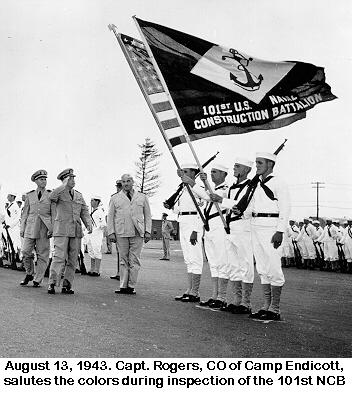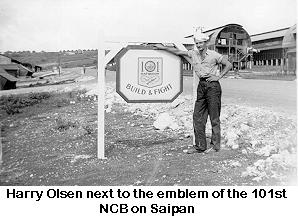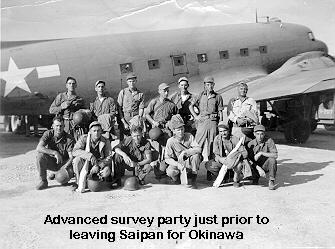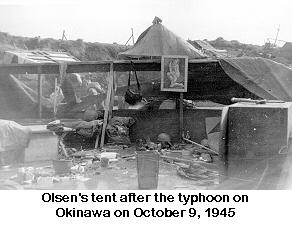Seabee
History
Main Page
Seabee Log Index
Today's Seabees
Home
Offsite links
Museum
Seabee Veterans
Official
History
Marvin
Shields
101st Naval Construction Battalion's History As I Remember It
By Harry Olsen
Chronology of movement of the 101st NCB in World War II
Author's note: I am not a historian or a writer. I did not keep a diary, journal or log book but after fifty plus years, I feel the urge to write about my experience in the 101st. Seabee Battalion that is to the best of my memory.
I enlisted in the Navy in the winter of 1942. At that time I was working for Peter Kiewit Son's Construction Company as a engineering aide in Colorado Springs, Colorado. We were working on two projects: Peterson Field and Camp Carson.
Boot Camp at Camp Peary, Virginia
In April 1943, we boarded a train in Omaha Nebraska. Our destination was boot camp at Camp Peary, Va.
We arrived late one afternoon after a few days on the train. They issued us our gear, which included one Navy (or Army) olive drab blanket. We were assigned a cot in a long and drafty building. I remember you could see through wide cracks in the building walls. I think that first night was one of the coldest in my memory.
Our "military training" began the next day. Early reveille, early chow, and then to the barber to get our head's shaved, and then they taught us how to dig "foxholes." I remember thinking, where else could we be standing in mud and water up to our hips and have sand blow in our face.
During our boot camp training we were restricted to camp for six weeks. When we finally received our first "liberty," a group of us, in Headquarters Company, decided to check out Washington DC. We had fun, and after visiting some of the historical points of interest, I think we began to realize just why we volunteered to fight for our country.
Military Training at Camp Endicott, Rhode Island
 After boot camp, our battalion boarded a "military
special" train. We were not told where we were going as this
was SOP (standard operating procedure) with the military during
World War II. We were told later that our destination was
Davisville (Quonset Point) Rhode Island.
After boot camp, our battalion boarded a "military
special" train. We were not told where we were going as this
was SOP (standard operating procedure) with the military during
World War II. We were told later that our destination was
Davisville (Quonset Point) Rhode Island.
The 101st NCB was quartered at Camp Endicott, located on the base at Davisville. This was a beautiful campsite, right on the Atlantic Ocean Our training continued at a more advanced pace. As I remember, included many days practicing landings in LST's.
I don't recall just how long we were at Quonset Point. Our stay there was uneventful. My friend, Carl Tefft, and I spent one of our liberties in New York City. I remember we visited Radio City Music Hall, where he heard Kay Keyser's College of Musical Knowledge radio show. I was chosen out of the audience to sing Popeye the Sailor Man while Kay Keyser was stuffing spinach from a can down my throat. I received a letter from my Mother later, telling me that she heard the broadcast back in Lincoln, Nebraska. I was a celebrity, in Lincoln.
More Military Training at Gulfport, Mississippi
Our next adventure found us boarding another "military special" train. It was a long trip and we finally were told that our destination was Gulfport, Mississippi.
At Gulfport our training again accelerated. And although we spent more time on amphibious landings, most of our time was spent on building or making things. I think the Seabees invented pallets. Webster's New American Dictionary describes a pallet as "a portable platform for transporting and storing materials". I can think of many better descriptions. Like, "a contraption made out of boards full of slivers, requiring hundreds of nails, and to be assembled in 110 degree heat and 100% humidity."
Gulfport must have been the birthplace of the 15 mile hike with a full pack. Even though I was only in my twenties at the time, believe me, I was one tired Seabee at the end of one of those hikes.
Gulfport was the first place I remember hearing about Island X. I also remember the infamous Cat Island where we did a lot of training. I'm sure many Seabees will fondly remember Cat Island.
One of the good things I remember about Gulfport was the fact that it was close to New Orleans. Those liberties in New Orleans were something else. The oysters were great and so was the old Absinthe Bar.
Shipping Overseas from Port Hueneme, Calif.
Scuttlebutt was rampant that the 101st NCB was shipping out. And sure enough, before long we loaded aboard another "military special." What a ride that turned out to be. I never realized how many days it would take to get through Texas. It seemed to take forever.
As usual we were not told where we were going. Texas finally turned into New Mexico, New Mexico into Arizona and finally Arizona into California. Everyone was excited to be in California. Maybe we could see some movie stars. Finally word came down that our destination was Port Hueneme. The 101st NCB was quartered at Camp Mugu, a few miles south of Port Hueneme.
Camp Mugu was not exactly the Ritz. Every Battalion that came along did something to improve things though. Again everyone seemed to be on their good behavior, so they would not miss out on Liberty. Hollywood was not very far, and we didn't have any problem getting a ride. Highway 1 was just outside the gate, and there were some fancy cars, with very nice people in them, waiting to give us a ride. We also continued to train for that day when we might be called on to do our job. As I recall the training was not as intense as before. They must be letting us get a little R&R before that day we knew would be coming.
Marine Training at Aiea Heights, Hawaii
Again more Scuttlebutt: the word was we were shipping out. This time on a real ship. After all we were in the Navy, right? Our ship was the SS Somelsdyke, a Dutch ship, presumably leased to the U.S. Government. As usual no one, not even the Skipper, knew our destination, but he would open the orders at sea. After a few days, we were told our destination was Aiea Heights, Oahu, Hawaii.
Sounded like more tough duty, like California. Hawaii was great, as far as weather, body surfing, sightseeing and sea shell hunting. Sure tough on the single guys though. Not enough girls to go around.
Our training continued, this time under the Marines. Everything they said about Marine sergeants was true; they showed no mercy. I remember jumping into a lake, or pond, from a platform with a full pack and helmet, into burning oil floating on top of the water. Not my idea of fun. I also remember we had practice maneuvers out in the pineapple fields, under live ammunition being fired by the Marines. Once in awhile we could reach out of our foxholes, grab a pineapple the harvester missed, and slice it with our machete's. That's what you call fresh.
I recall a night march through some kind of weird forest vegetation. It was so dark, we didn't realize till the moon came out that we were about 30 feet off the ground. We were super careful after we found out where we were.
The Invasion of Saipan
Again the Scuttlebutt started, and in about a month we were loading aboard another ship. After we were at sea for several days the word come down that our destination was the Marinas Islands.
It was a long trip. When we finally got our sea legs, and after the decks had been swabbed, and the potatoes peeled, we could lay on the deck shirt less, and soak up some rays. Also many poker and crap games were in progress on deck.
After we were at sea for what seemed like an eternity, the weather started getting nasty. The ship began wallowing around like a drunken whale, pitching and tossing, not only from port to starboard, but from bow to stern. Everyone below decks were either in their bunks or had their heads stuck in GI cans. It wasn't the most pleasant place to be.
I had never been seasick, airsick or car sick but that scene was starting to get to me. I went up on deck. The only way to keep from being swept overboard was to wrap both arms around something and hold on for dear life. We were told later that we had just experienced the tail end of a typhoon. Welcome to the Marinas.
In the next few days we started seeing many ships. We were sure something big was about to happen. Our destination was Saipan.
All those ships kept milling about in that big ocean, they seemed to be waiting for a signal of some kind. Then at a distance we could hear the booming of the big guns on the battleships. We were told that they were pounding the Island in a softening up process. In the meantime we sailed aimlessly in circles, awaiting orders.
 Soon word came down that the invasion would begin, and
that our battalion would be involved in one of the early
landings. The Marines were the first to land, and we were right
behind them. Our fox hole digging practice paid off.
Soon word came down that the invasion would begin, and
that our battalion would be involved in one of the early
landings. The Marines were the first to land, and we were right
behind them. Our fox hole digging practice paid off.
When we finally were able to get off the beach, and our area was secured, we started unloading supplies and equipment, tons and tons of equipment. We started pitching tent's in the mud. It was rainy and muddy for days. It didn't do much good to unload the trucks from the ship. They seemed to be stuck most of the time.
Saipan was hot and humid, and the mosquitoes were everywhere. We had to take attabrine tablets every day to ward off malaria, and dengue fever. Even so, many of us got the bug.
After several weeks the island was declared "secure." The surveying crew was busy laying out roads, camp sites, ammunition bunkers and dock's for unloading more cargo. I was assigned to a crew that was laying out a water supply line, from a spring up in the hills, to a new camp for 24th Army Infantry Battalion. We were told one of their main assignments was to finish securing the island.
This was at the north end of the island, near what was later called "suicide cliff". The south side of the cliff was honeycombed with caves. These caves were hiding places for many enemy solders. It was an eerie feeling, standing in the open, next to the engineering transit I was using, knowing that I was being watched, and that some sniper could be aiming a rifle at me. I could look through the transit and see them moving around in the caves. It was some comfort, having my carbine slung over my shoulder, in case one of them wanted to get closer. In some areas we were accompanied by a platoon of Marines, and it was also comforting to have all those extra eyes scanning the bluffs for any movement.
The water line continued through one of the densest jungle areas on the island. Every day we would discover a new bivouac, that only minutes before had been vacated by enemy soldiers. They lived mostly on snails or slugs that they found. They contained them in sort of a bamboo like tub. For some reason we always seemed to have the urge to relieve ourselves whenever we saw one of those tubs.
Our camp, after completion, was one of the most attractive on the island. It was located on a gentle slope facing west with a fantastic view of a beautiful coral reef. We even had our own theater, situated on a natural slope, with a covered stage. Later we had live shows from state side, courtesy of the USO. It wasn't long before we started having uninvited guests. Our former adversaries would sneak in, under the cover of darkness, to see the shows. Evidently they were also getting "island fever."
After settling into a routine, life began to be very boring. Thank goodness for mail call, chow call and the shows.
The Advanced Survey Party's Deployment to Okinawa
After several months, the scuttlebutt began again, and we knew we would be on the move once more. Everyone knew that the eventual target of the US forces was to make the big landing in Japan. But first, more invasion points, nearer to Japan, had to be established. Our destination was this time Okinawa.
One day our Executive Officer called the surveying crew into his office. He told us we were under "secret orders" to proceed by plane to Okinawa. Our mission was to lay out or survey the Island of Tsuken Jima for a Marine fighter strip. We loaded aboard a C47 transport plane (the Navy designation was R4D) at 04:30 hours. The plane was sitting on the far end of the Saipan airstrip. There were 30 of us, plus our gear, which included surveying equipment and our carbines.
Our ride from Saipan to Okinawa was uneventful. until our Pilot announced we were nearing Okinawa, suddenly the air seemed full of planes. It seemed we were flying through the middle of a "dogfight", all eyes were glued to the windows, straining to see if the planes swarming around, had blue stars or rising suns on their wings. Thank the good Lord, our planes out numbered their planes, otherwise we would be have been easy pickings for the Japanese Zeros.
 We landed on Yontan airstrip on the main island of
Okinawa. The minute our aircraft came to a halt, we were ordered
to "hit the runway, running." It seems the airstrip had
not been secured, and that the Marines were still attempting to
secure it. Our orders were to defend our aircraft perimeter, and
after a couple of small skirmishes, we were successful. We were
told later that we were the first unarmed airplane to land on
Yontan airstrip during the invasion of Okinawa.
We landed on Yontan airstrip on the main island of
Okinawa. The minute our aircraft came to a halt, we were ordered
to "hit the runway, running." It seems the airstrip had
not been secured, and that the Marines were still attempting to
secure it. Our orders were to defend our aircraft perimeter, and
after a couple of small skirmishes, we were successful. We were
told later that we were the first unarmed airplane to land on
Yontan airstrip during the invasion of Okinawa.
From the airstrip we headed for the beach at Buckner Bay We were assigned a small landing vessel, and someone pointed out the small island of Tsuken Jima off in the distance. The Island was fairly flat and was approximately fifty feet above sea level. A Marine contingent landed on the Island with us. We were very happy about that. After scrambling up the cliffs, we discovered we were not alone on the Island. The Marines soon had the Island secured with the exception of a few survivors holed up in the caves.
We lived in our foxholes, with ponchos to protect us from the rains. Our living conditions were deplorable. Since we were not attached to any unit, we had to fend for ourselves. It was a muddy, miserable existence. C- Rations and K- Rations, which were dropped to us by small spotter planes, started tasting like the mud we were sleeping in.
Finally someone got the bright idea of trading the souvenirs we found in the caves to the ships anchored in the harbor for steaks and ice cream. Things improved considerably after that.
Since geodetic maps were unavailable, we had to establish our position (latitude and longitude) and elevations for surveying purposes. Using transits we established our position by triangulation on the stars and the elevations by taking mean (average tide readings). After this information became available we began to lay out the airstrip for fighter planes to land.
We had a close up and personal introduction to the Japanese Kamikaze attacks while on Tsuken Jima.
We didn't need alarm clocks. Promptly at eight o'clock every morning we could hear the kamikaze planes coming in from the west. The anti-aircraft batteries that were positioned in a semi circle along the cliffs on the main island started firing at them. At the same time the Navy ships in the open sea on the other side of our island were adding their firepower. We were, in effect, in a cross fire between the land based and the ship based anti aircraft barrages. The lower the planes flew, seeking a target to crash into, the more direct hits our island received.
It was always an exciting show. We had additional foxholes available for this eventuality, but seldom used them. I would stand out in the open looking through the transit. I could clearly see the pilots, leather helmets on, their goggles pulled down over their eyes, and the traditional white scarf around their neck. The intensity and determination on their faces, as they chose which ship to crash their planes into, is still etched in my memory.
One morning, a young Marine was standing beside me. We were watching the show, when a 20mm round from a shore battery, caught him full in the chest. I never even knew his name. This too is still etched in my memory. From then on we made use of the foxholes.
After our assignment on Tsuken Jima was complete, we rejoined our battalion, and our work became more routine. Roads, ammunition dumps, docks and camp sites had to be built. Our camp site consisted of tents on wooden platforms, situated in rice paddy's that had been drained. We had a few Quonset huts for the medics and chow halls. The natives made remarks about our camp's vulnerability in a big storm. Guess what? They were right. When the big typhoon came, no more tents and no more Quonset huts. It was one of the most ferocious storms to hit Okinawa in decades. Smaller ships were blown onto the shore. The wind was so strong I remember we could not crawl on our hands and knees against it.
Some of my friends and I from Headquarters Company moved the urns out of the hillside burial tombs, and we moved in. We stayed there about a week, fortified by some spirits supplied by our medic friends and from a guy named Charlie, from one of the Carolina's. He made the best moonshine on Okinawa.
Soon after our camp was rebuilt we were rocked by big earthquake. I happened to be looking through a transit at the time. The magnification showed the twisting, turning, and buckling of the earth. The sensation was worse than I ever received from the spirits mentioned above.
End of the War and Homeward Bound
One day the news came !!! We had dropped an atom bomb on Japan. We felt a sense of relief. We realized that perhaps we would not have to invade Japan, and that maybe the war would soon be over. You can bet, we listened to every radio news broadcast we could, from then on.
One morning, I think it was August 1945, we awakened to shouting, bugle blowing and other assorted noises. The Japanese had surrendered. The war was over. Immediately we began asking "when can we go home?" Then we began hearing something about a point system. The formula, as I remember, included length of service, married or single, number of children etc.
 Sometime in November 1945 I had enough points, and
boarded a ship headed for San Diego California. From there I was
sent to St. Louis Missouri and was given an honorable discharge
from the U.S. Navy.
Sometime in November 1945 I had enough points, and
boarded a ship headed for San Diego California. From there I was
sent to St. Louis Missouri and was given an honorable discharge
from the U.S. Navy.
To borrow a phrase from Paul Harvey, "now for the rest of the story." It's June 1997. I will be 80 years old September 30th and I am still in good health, living in a place called Lake of the Pines, half way between Auburn and Grass Valley (in California's gold country), California and playing golf three times a week. Last but certainly not least, I thank God, for letting me live for these 80 wonderful years.
Story Copyright © 1997 Harry
W. Olsen.
All rights reserved. Used with permission.
| Bulletin Board | Keyword Search |
| Bookstore | Links |
| About Us | Recent Additions |
![]()

